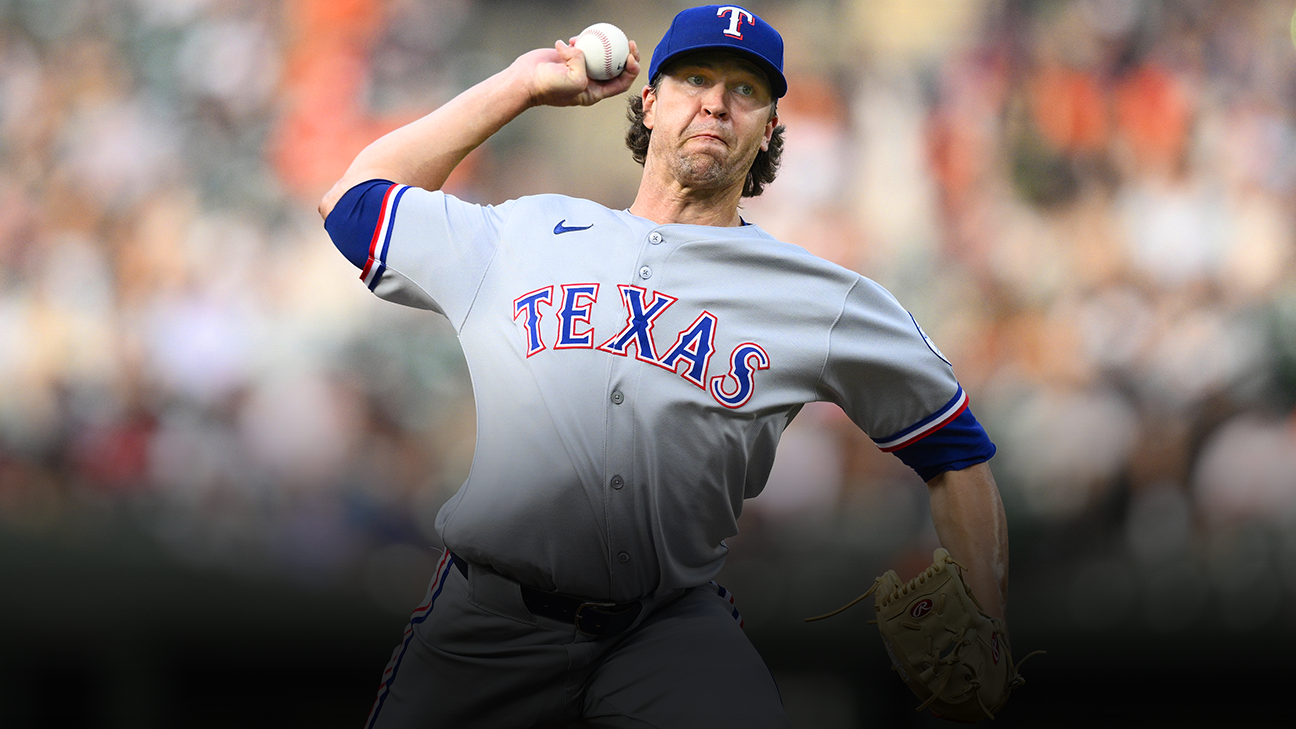NEW YORK — Clay Holmes, Tylor Megill and Griffin Canning have a few obvious things in common. They’re right-handed pitchers. They’re members of a Mets starting rotation that has so far trounced external expectations, posting the lowest collective ERA in baseball. And, for different reasons, each is striving to prove he belongs.
Dig a little deeper, though, and another connection can be found, hidden within each of their pitch arsenals this season: the kick change, a changeup-splitter hybrid that has surged in popularity since San Francisco Giants right-hander Hayden Birdsong introduced it to Major League Baseball a year ago.
Holmes began working on the pitch in November, intent on mastering the offering to ease his upcoming transition from reliever to starter. Megill, seemingly always the odd man out of the Mets’ rotation since debuting in 2021, saw all the uproar around the pitch and tried it toward the end of the offseason. Canning, a once-hyped prospect seeking to rebound on a one-year contract, threw his first kick change warming up for his Mets debut in Houston, having fiddled with grips on the bench the day before.
Together they have combined for a 2.66 ERA in 108⅔ innings across 21 starts for the club with the third-best record in baseball. The kick change is just one factor in their success, and a recent product of a larger data-driven trend dominating the industry over the past decade.
“You have guys that are maybe looking for a job or they’re incentivized to try something new, and they get it to work and then it spreads like wildfire,” Mets pitching coach Jeremy Hefner said. “It’s a copycat league. It’s always been a copycat league.”
THE KICK CHANGE, in layman’s terms, is a modified changeup. It features a changeup-like grip and generates changeup-like spin but has splitter-like movement — think vertical depth — and is thrown harder. A traditional changeup has more fade, moving horizontally to the pitcher’s arm side. When optimized, a right-hander’s kick change can resemble a left-hander’s curveball.
What makes the kick-change grip different is the middle finger is spiked — raised off the ball (pitchers’ fingers lay flat on the ball for traditional changeups). Spiking the middle finger “kicks” the ball’s axis forward through release, which alters how the ball spins and produces the pitch’s downward movement, while the ring finger cuts down efficiency, killing the spin to produce more tumble.
There are subtle variations to the grip: Megill, for example, has bigger hands so he spikes his middle finger more than Holmes and Canning; finger placement along the seams can also vary.
The pitch and its swift spread exemplify the technological advancements made in the sport and the resulting increased willingness for players to experiment to discover every edge possible. Accordingly, different pitches — whether new inventions, recycled offerings or conventional pitches used in other ways — have become en vogue seemingly every year.
“I think it’s just looking at, what do we know about the ball?” New York Yankees pitching coach Matt Blake said. “What do we know about spin dynamics? And how do we keep evolving guys’ arsenals? And I think, with this one in particular, you see one guy get it and the league has all the tracking tools. So, anyone that comes through and throws a certain pitch, you get a look at it. It just gets replicated along the way.”
At the turn of the decade, the sweeper took the sport by storm. Before that, the high fastball became a geek favorite and filtered down to the players. This year, it’s the kick change’s turn.
THE THREE METS starters are part of a growing group of kick-change aficionados.
Chicago White Sox right-hander Davis Martin became an early adopter last season after Birdsong’s success. New kick-change operators this season include Texas Rangers rookie right-hander Jack Leiter and Minnesota Twins veteran right-hander Pablo Lopez, who has also continued throwing a traditional changeup.
“I picked it up toward the last one or two weeks of spring training,” Lopez said. “And right now it’s to the point that if certain days it’s moving, I’m like, ‘OK, it’s pretty good.’ Some days it’s just floating. Don’t want to throw a floater against Bobby Witt Jr.
“My normal changeup still gets movement. It still gets swings. I can locate it better. So, if I throw two in the pregame bullpen and that thing is just floating or sailing, I’m like, then it’s not the day for it. I’ll throw one in the warmups to see if it’s there.”
The best traditional changeups are usually thrown by pronators — pitchers with a pronation bias, meaning they tend to throw a baseball by rotating their forearm and wrist inward. Supinators rotate their forearm and wrist outward, positioning them better for breaking pitches with glove-side movement.
In 2023, Leif Strom, the director of pitching at Tread Athletics, an independent pitching development lab outside of Charlotte, North Carolina, sought to find a pitch for supinators to better neutralize left-handed hitters. Strom scoured Tread’s internal archives in search of pitches with the desired movement profile and found fewer than 50 thrown. Using those pitches as models to study, Strom is credited with identifying, naming and applying an understanding of the kick change.
“We started to see some on X or Instagram, and when I started to see those that’s when I thought it would probably be a big thing because effectiveness is one part of the equation,” Strom said. “If this pitch is effective, it’s going to spread no matter what.
“But in terms of a pitch spreading quickly, I feel like you have to have a visual component that the sweeper did. And it just so happened that the kick change had that visual component.”
Birdsong, a 2022 sixth-round pick who had reached Double-A in 2023, was the first major leaguer to throw one in a game in June. He developed it last year after reporting to camp frustrated with his changeup.
“I tried 100 different grips and nothing worked,” Birdsong, 23, said. “I was throwing just a really bad fastball.”
He finally found his answer when he watched a video of the kick change on social media. He started throwing it the next day in spring training and it immediately clicked. He used it in his next bullpen and managed to throw a changeup with a negative vertical break — a metric used to quantify a pitch’s vertical movement in inches — for the first time in his life. He honed it from there.
Birdsong made his major league debut in June and threw the pitch 18.4% of the time over 16 starts. This year, working out of the bullpen, his kick change usage is up to 24.1%. It has a 46.7% swing-and-miss rate and has held hitters to a .188 batting average. He owns a 1.47 ERA in nine relief appearances.
The White Sox’s Martin was introduced to the pitch between starts in August by Brian Bannister, Chicago’s director of pitching, and Ethan Katz, the team’s pitching coach. Martin reached the majors in 2022 and threw his changeup about 10% of the time that season. But in his first major league start of the 2024 campaign, he gave up four runs in 3⅔ innings without throwing one at all.
“I went out to play catch,” Martin said, “and they were just like, ‘Yeah, your changeup sucks.'”
On the spot, they showed Martin the kick-change grip, and he threw a few from 80 feet. The first one felt weird. The second one tumbled enough to think there was something there. He then threw a few off the mound and the movement remained. A day later, he held the Athletics to two hits over six scoreless innings.
“I threw like 21 or 22 of them,” Martin said.
By autumn, the pitch was no longer a secret — and one free agent in particular took note.
UNLIKE BIRDSONG AND Martin, Holmes was an established major league pitcher with two All-Star nods when he dipped his toe in the kick-change pool.
Last season, while still closing games for the Yankees, Holmes dabbled with a traditional changeup during bullpens at teammate Luke Weaver’s urging. Holmes quickly developed one that wowed Weaver, a changeup specialist. But given his role pitching late in high-leverage situations, Holmes chose not to throw any changeups in games.
“His changeup was sick,” Weaver said. “And we would talk about it a lot, and I was like, ‘I’m done talking about it. Until you go prove it in a game, I don’t want to talk about it.’ Just joking with him. But then he went in the offseason, and he elevated it.”
When teams contacted Holmes in free agency with interest in converting him back to a starting pitcher — he broke into the majors as a starter for the Pittsburgh Pirates in 2018 — Holmes knew the move would require implementing a pitch against left-handers to complement his repertoire of sinker, slider and sweeper. The changeup he sharpened in those bullpen sessions during the 2024 season was good, but he probed for better. Eventually, Holmes, a supinator, landed on the kick change working remotely with Tread Athletics.
“I threw some good ones early on with it and definitely felt uncomfortable, felt different,” said Holmes, who signed a three-year, $38 million contract with the Mets in December. “But I kind of knew some good ones were in there and so I just kind of kept messing around, kept tinkering with it until I found something that felt good. And just kind of started to evolve over the offseason.”
Holmes’ kick change was ready by the time he showed up in Port St. Lucie, Florida, for spring training. Strom recalled seeing one Holmes threw during an exhibition game — 88 mph with a negative 10 vertical break — as one of the best he’s seen.
More importantly, the kick change has helped the 32-year-old Holmes record a 2.95 ERA through seven starts. He’s using the pitch 16.2% of the time, holding opponents to a .182 batting average with one extra-base hit and a 38.2% whiff rate. The kick change isn’t merely a luxury for Holmes — his pitching coach believes his shift to the rotation might have been a lost cause without it.
“I would say no, it’s not possible without the changeup, some form of the changeup,” Hefner said. “Whether it’s the split or a kick change or a traditional circle change, he needed that versus lefties just to give them another look.”
Late last month, Holmes assumed the role of kick-change instructor. Megill had used a kick change earlier in the season, replacing his splitter with it, but the pitch just wasn’t feeling right anymore. The grip seemed off and it wasn’t good enough to use in games. So, he sought help from Holmes during a bullpen session, and they worked together to change the grip.
“That made it a lot more consistent,” the 29-year-old Megill said.
Three days later, on April 21, Megill tossed 5⅓ scoreless innings and tied his career high of 10 strikeouts against the Philadelphia Phillies. Afterward, he highlighted his four-seam fastball and sinker, a pitch he incorporated last season, as the primary reasons for his success that night.
But he also generated three whiffs with eight kick changes, all thrown to left-handed hitters. When he found himself in his deepest trouble, with the bases loaded and two outs and slugger Kyle Schwarber at the plate in the third inning, he threw three straight kick changes and struck Schwarber out on an 88-mph offering. The pitch was out of the strike zone and Schwarber — who ranks in the 93rd percentile in chase rate across the majors — swung and missed.
Just like that, it became a weapon for Megill, who has a 2.50 ERA and 45 strikeouts across 36 innings through seven outings. He’s thrown 41 kick changes this season — 33 to left-handed hitters — with a 50% swing-and-miss rate and given up one hit with it.
“I got everything I need right now,” Megill said. “My first two times through [the lineup], I can get away all day with four-seam, sinker, slider. Third time through it’s like, all right, I need that fourth pitch. That’s where the changeup comes in.”
Canning’s relationship with the kick change is a bit different. The 28-year-old wasn’t desperate for a changeup after signing a one-year, $4.25 million deal with the Mets in December. Throwing a traditional changeup comes easy to him and he relied on one heavily during his five seasons with the Los Angeles Angels.
But Canning liked the vertical movement his kick change produced when he threw it for the first time warming up to face the Houston Astros on March 29. The grip alteration was minor; he spiked his finger ever so slightly to transform the ball’s trajectory. He ditched his traditional arm-side-fade changeup that day and held the Astros to two runs across 5⅔ innings in his Mets debut.
Canning incorporated both offerings in a few April starts, giving hitters slightly different looks at the same velocity, between 88 and 90 mph. In recent outings, however, Canning has ditched the kick change, at least temporarily.
“I think it’s actually helped me with my regular changeup,” said Canning, who is sporting a 2.50 ERA through seven starts after compiling a 5.19 ERA with the Angels last year. “It’s part of the season, part of the ebbs and flows.”
Canning said he could end up throwing the kick change again this season. But it’s not essential for his success, not in the way it is for Holmes. It’s another tool in his kit, one that is helping the Mets perplex opposing hitters this season — just as it is for a growing group of pitchers across the majors.
“Everybody thought I was weird for throwing it,” Birdsong said. “Then it took off and it moved to different orgs. And now it’s everywhere.”
ESPN’s Jeff Passan contributed to this report.
Source link

















